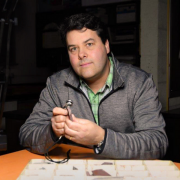Q&A: Using science to uncover a potential gold mine
November 9, 2021
Share

Queen’s researcher Peir Pufahl, Professor, Geological Sciences and Geological Engineering, and Co-Director of Queen’s Facility for Isotope Research, is getting a taste of high-profile screen time as he helps Rick and Marty Lagina, from the popular show The Curse of Oak Island uncover the mysteries of the Nova Scotia island.
A 224-year-old legend claims there is a golden treasure hidden beneath a murky swamp. An assortment of archaeological techniques have been used to get closer to the potential fortune, including seismic testing, sonic core drilling, and ground-penetrating radar.
This season, Dr. Purfahl offers his expertise, and takes a closer look at 12 boreholes to determine if they actually contain elements of gold.

How did you get involved with The Curse of Oak Island series?
My colleague and friend Dr. Ian Spooner from Acadia University invited the Queen’s Facility for Isotope Research (QFIR) to analyze water samples from boreholes. I co-direct QFIR with Drs. Dan Layton Matthews, Matt Leybourne, and Heather Jamieson. The lab has a world-renowned reputation for the analyses of waters that may contain more insoluble elements such as a gold.
Is this a departure from the normal scope of work in the Isotope lab?
No. What’s cool about this work is that we’re using tools QFIR routinely applies to explore for mineral deposits with our company partners. We used the same chemical finger printing techniques we routinely use to look for ore deposits but in this case, we are applying them to hunt for pirate treasure.
Walk us through the process of how you analyzed the borehole samples. What type of equipment did you use?
Dr. Spooner took water samples from boreholes that were drilled in previous seasons of the show. These boreholes were drilled with the hope of discovering old workings and treasure. They’re now filled with ground water that has leached elements from the surrounding soil and rock. If treasure does exist, it should leach elements like silver and gold into the water. The concentrations of 65 elements were analyzed using inductively coupled plasma mass spectrometry (ICP-MS) in QFIR. Some of these elements are associated with gold and are therefore also good indicators of potential treasure.
Your findings conclude the samples contain gold — what does that mean for Oak Island?
This finding is significant because it is the first time in eight seasons of the show that there is a direct indication of gold, which may result from treasure or naturally occurring gold leaching into the ground water.
What do you hope this international research exposure will mean for the lab?
A few things. Number one, it is a great example of how the techniques we use on a routine basis in QFIR are transferable to solve unique real-world problems. The fact that the show is one of the top-rated reality cable TV shows in the world provides an unparalleled opportunity to showcase these techniques to millions of people that would otherwise not be exposed to the inner workings of how science works. Second, QFIR's involvement is great exposure for Queen’s and the Department of Geological Sciences and Geological Engineering to such a huge arena of people. Our work highlights the relevance of what we do and how we do it. Third, our collaboration with the Oak Island team is a fantastic recruiting tool. We’ve already had inquiries from students in the U.S., where the show premiered on Nov. 2, about Queen’s and our department.
Are there any future plans to work with the series?
Yes, but mum's the word.
The Curse of Oak Island has just launched its ninth season on the History Channel.